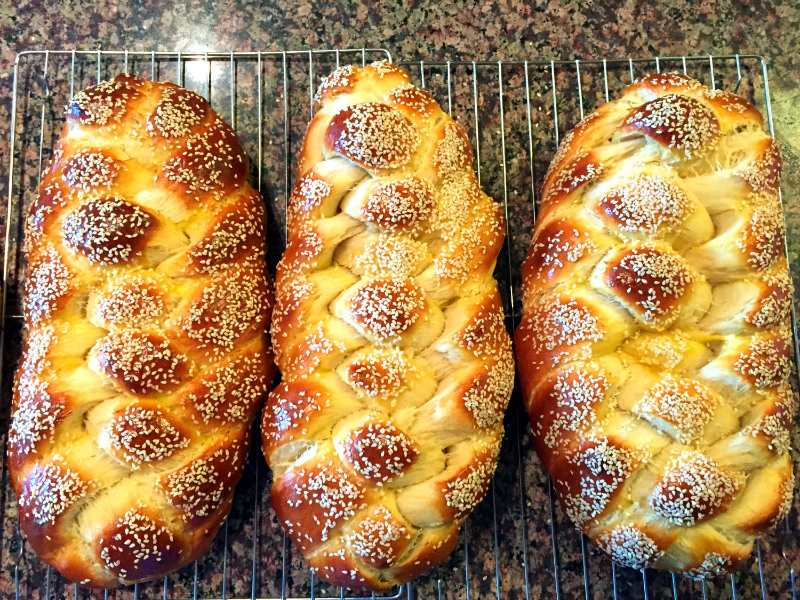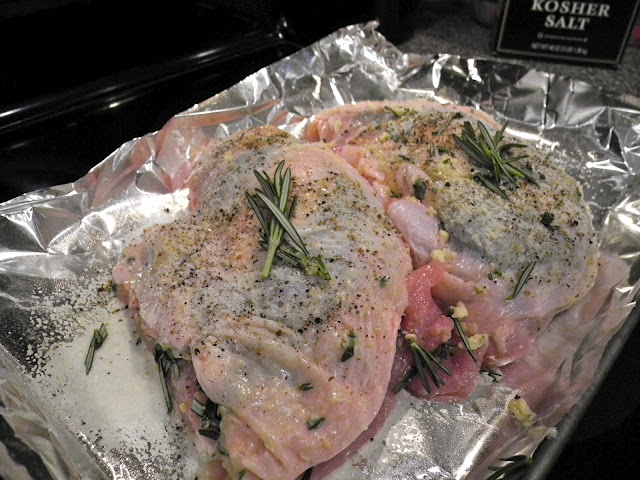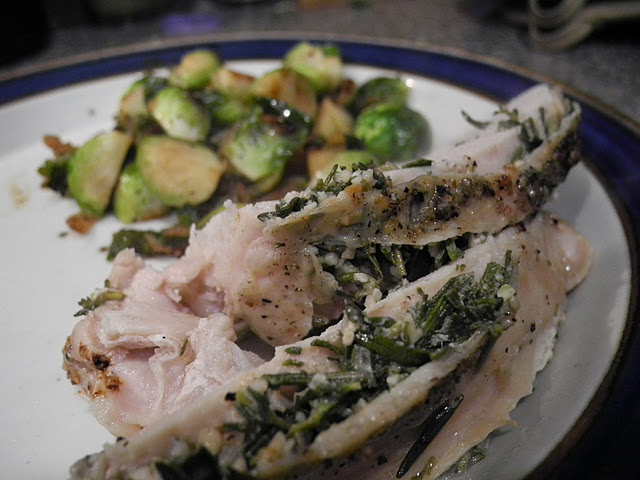How to Herb-Roast Turkey Breasts and Conquer Thanksgiving
Thanksgiving is a tough holiday for chefs. On one hand, it's a moment in which skills can shine and new and creative versions of traditional dishes can be crafted. On the other, the person(s) in charge of planning and executing the menu fight two uphill battles only tangential to ability in the kitchen:
- Thanksgiving inspires in many Americans a series of clearly-defined expectations (e.g. "THAT's NOT THE WAY MY MOM MADE YAMS!!!"), and
- Thanksgiving is an organizational nightmare.
To the first issue: there's almost no overcoming the "expectations" challenge, unless everyone around the table has had similar lifelong Thanksgiving experiences. So, instead of leaping over the hurdle, I say bust right through like the Kool-Aid guy crashing through a wall. Instead of being subtle and mixing recipes up just a little, do something different enough to circumvent expectations. No, I'm not going to provide you alternatives for every dish, but how about we start with one strategy you can employ with the Turkey?
NOTE: I say "Turkey" with a capital "T" (which rhymes with P which stands for pool) because Turkey is the centerpiece of any (non-vegetarian/alternative) Thanksgiving. Have you ever seen a Thanksgiving spread without a shining, golden, monumental KING Turkey perfectly centered among the sides?
Anyway, one still-impressive but rather easy way to jazz up the Turkey is by herb-roasting a few breasts. I suppose this only works if you're feeding people who tend to prefer white meat; however, the method I'm about to elaborate includes a little dark as well.
Last item before we dive into process and pictures: You need to know how to message this to your troops. In choosing not to roast, fry, brine, etc. a whole turkey, you may well get complaints (or at least questions). So here are the four "breast" reasons (hahahahahah) to use:
- It's easy. You don't need strange equipment (as you might with brining or frying) or exotic ingredients.
- It's faster. We're talking just about an hour in the oven. Trust me: not having to worry about oven timing really helps to overcome aforementioned Thanksgiving challenge number two.
- It means better white meat. Ever notice how white meat on whole roasted turkeys tends to dry out? That's because the dark meat requires more time in the oven, so by the time the thighs and whatnot are done the white meat is desert-like.
- It can be scaled to fit the crowd. You can just keep on adding breasts until you hit the magic quantity, about a pound of meat per person. Hopefully, there will be leftovers.
Ok, here we go. I bought an almost-whole eight-pound turkey (without drums or wings). Why this particular cut? A) It's pretty cheap (stores like selling the wings and drums separately for a markup), and B) it's much easier to find than solo boneless breasts.
I started by preheating my oven to 400 degrees. With a sharp knife, a lot of care, and a little adventurousness I removed the breasts and thigh meat in two big pieces and reserved the rest of the bird for soup stock. Here's where we were at this point:
Using paper towels, I patted the skin dry and transferred the meat to greased tin foil atop a baking pan. Next, I melted about 4 tablespoons of butter on medium power in the microwave and set that aside to cool while I prepared my herbs.
I used about five sprigs of rosemary and ten of thyme for each breast. I stripped off the leaves and minced them up with some pre-minced garlic (one of my favorite kitchen staples) and created a sort of super fragrant mush. Next, I used my fingers to peel the skin away from the meat on the top of the breasts, careful not to pull the skin off completely -- the goal is to create a sort of pocket. Then, I stuffed the pockets with the herbs, trying to ensure I'd maximized coverage of the meat.
Using a silicon brush (although fingers will do), I took my now slightly-cooled butter and rubbed it all over the top of skin and around the breasts, doing my best to provide full coverage. Finally, with the butter as the cement, I provided the meat with a very generous topping of salt and pepper. As you can see, I finished it off with a little sprig of extra rosemary; unnecessary, I assure you.
The final, pre-oven effect:
Before roasting, I wrapped the meat reasonably tightly in the foil. The idea here is to both preserve the runoff juices for whatever gravy one might wish to make, but also to prevent the meat from drying out. After closing it up, I threw the pan in the oven and set it to roast for 50 minutes (about 10 minutes per pound of meat, although I suppose it was only an estimate that I had obtained five pounds of meat from the eight-pound almost-whole bird).
After 50 minutes, it was time to ensure the skin would become crispy and delicious, which meant exposing the top of the breasts. Using a knife, I cut a large "X" in the foil and peeled it back from the turkey and set the timer for another 15 minutes.
Finally, after a total of an hour and five minutes, having checked the meat, we were ready to dive in!
***If you choose to make a gravy, simply pour the juices into a saucepan over medium. Thicken with all-purpose flour, constantly stirring.
 food thoughts,
food thoughts,  herbs,
herbs,  recipe,
recipe,  turkey
turkey 








Reader Comments (2)
Did the breasts actually come out juicy?
Uh, now that didn't sound good.
You're a few days too late unfortunately, because last week I took a top quality brand turkey (unbeknownst to me at the time), took the breast meat, ground them and made burgers! Whoops. :-)
A) Yes, they totally did. The photos almost didn't work right, in that the turkey was so juicy it almost looked underdone (it wasn't, I promise!)
B) I'm probably a couple days late for EVERYONE, so no worries =)